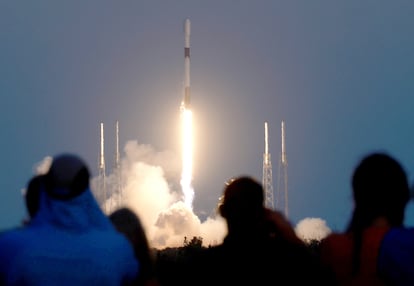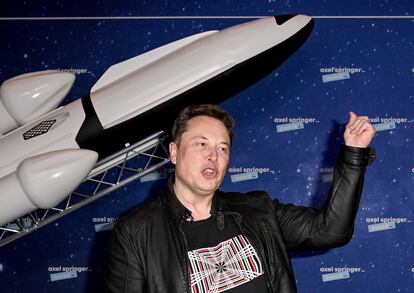Satellites: the new economic battle being waged 600 miles away from Earth
Taking control of space is a priority for billionaires and world powers. Whoever moves fastest will be able to dominate information and communications


The conversation takes place on one of SpaceX’s American rocket launch platforms, owned by billionaire Elon Musk.
“I congratulated [Musk] on his ambition to reach Mars… something he was close to achieving,” recalls a senior executive at a Spanish satellite company, who requested that EL PAÍS protect his anonymity.
“And what was his response?”
“You haven’t understood anything! Getting to Mars isn’t a complex issue — the mission of this company is to colonize,” the executive says, repeating what Mr. Musk supposedly told him. The company’s “purpose is to colonize the entire planet and exploit its natural resources,” he sighs.
This conversation reveals the character of the Silicon Valley oligarch. Despite being incomprehensible at times, he certainly doesn’t bluff.
Tesla, X (formerly Twitter) and SpaceX are well-known conglomerates. Many analysts argue that Musk repeats the same monopolistic strategy wherever he goes. With a fortune of $202 billion, he seems disinterested in money, although he leaves clues about what he’s really after. “Between Tesla, Starlink & Twitter, I may have more real-time global economic data in one head than anyone ever,” he tweeted back in April.
He wants to utilize this information to reach Mars. Meanwhile, from Earth, industry and competition in the field of space exploration are taking off. Communication satellites — according to Morgan Stanley — are generating about $70 billion dollars a year, while observation satellites are pulling in nearly $10 billion. But these numbers will likely grow significantly. The consulting firm Research and Markets expects that observation satellites will generate $24.2 billion annually by 2030, while Euroconsult calculates that communications satellites will bring in $123 billion each year by 2032. Overall, Bank of America estimates that, by the end of this decade, the space economy will be worth a total of $1.4 trillion. And Matthew Weinzierl — an economist at Harvard Business School — believes that 95% of revenue will come from satellites, especially low-orbit ones. “If geopolitical tensions don’t get out of hand, the space is large enough to distribute benefits to everyone,” he opines.
But today’s space has nothing to do with the one that President Kennedy conquered with the Apollo program in the 1960s. Everyone now seems to be following a phrase written by science fiction writer Robert Heinlein (1948-1988): “Once you reach Earth’s orbit, you’re halfway to anywhere.” If you imagine space as being made up of overlapping lawyers, low Earth orbit (LEO) is located between 300 and 600 miles from Earth. This is where a major economic battle is taking place. And then, there’s medium Earth orbit (MEO), which ranges from 1,200 to 2,200 miles away, followed by the geostationary orbit. These lands are unregulated — nobody knows precisely how many satellites are potentially operable in LEO or MEO. Some compare it to the Wild West. Others — such as Miguel Ángel Panduro, CEO of Hispasat, a firm that operates a number of Spanish communications satellites — recall the oceans of the 15th century: “They lacked rules and laws, there were pirates…” Very low Earth orbits, which are just a couple of hundred miles away from Earth, are getting busier every day.

Elon Musk operates in low Earth orbit. His company, SpaceX, has found a way to build reusable heavy rockets: they launch the cargo into orbit and it returns safely. In 2019, SpaceX began sending up smaller communications satellites, which weigh about 570 pounds apiece.
They resemble flattened cars, with large panels that reflect sunlight. The New York Times nicknames them “flying sofas,” due to their modest size. These satellites communicate with terminals on Earth, so they can transmit high-speed internet to almost the entire globe. They also provide a phone system called Starlink. Elon Musk controls half — about 1,300 — of the existing 2,600. However, he wants to build 42,000. His company has offered internet connectivity (with a speed of 100 Mbps) to 60 countries.
Flying sofas
Without a doubt, the tech oligarch dreams of a sky filled with constellations of flying sofas. “The big change is that [SpaceX] manages the entire chain: they manufacture the rockets, they design the satellites (between 150 and 300 per month), they operate them, they create the applications and they sell them directly to the users,” Panduro summarizes. “And, furthermore, they offer a different price in each country. It’s the strategy of brute force. You have enormous resources and you can even lose money until the rest of the companies can’t take it anymore.” Being a private firm, few know how much money Musk gains or loses each time he launches one of his Falcon 9s. Supposedly, Starlink has 1,500,000 subscribers (airlines, cruises and telecom firms have flocked to sign up) and several experts estimate that the company subsidizes the cost of each internet terminal with $700.
Elon Musk would like to be alone in that low orbit. Of course, he controls it, but he still has competition. Telesat Lightspeed, AST SpaceMobile, OneWeb, IRIS2 (a European initiative) and, above all, Amazon’s Project Kuiper are looking to build a track record. In any case, it seems that space has become the playground of big tech billionaires. It seems that only Jeff Bezos can bring Musk down from his cloud. “Amazon has enormous potential. And, in the end, the great competition comes down to the two magnates,” observes Stephane Terranova, the CEO of Thales Alenia Space in Spain.
Bezos plans to provide Wi-Fi coverage through 3,236 satellites in low orbit. According to Amazon, this gives them the possibility of “flying the safest [network] constellation with the fewest number of satellites.” So far, however, they haven’t sent any up, although they have “secured 77 launch vehicles with heavy loads thanks to Arianespace, ULA (United Launch Alliance) and Blue Origin (owned by Bezos),” sources from Amazon say. “Combined, it represents the largest purchase of launch vehicles in history.” The schedule indicates that the satellites will start to be manufactured by the end of 2023, with the first tests starting in 2024. The devices last several years and will vary depending on each country. China, for instance, isn’t fond of open and unregulated Internet access.

In this space race in the LEO orbit, perhaps the last thing that anyone is worried about is money. “The goal should not be to find ‘Planet-B,’ as Elon Musk once said. It’s about focusing all our attention on our life on Earth. Space is a place for new ideas,” affirms Sophie Hackford — co-founder of the artificial intelligence company 1715 Labs — in an interview with The Economist. But reality shows that the business side of things is out of this world, especially when it’s controlled by an erratic billionaire.
“The satellite sector is an extremely strategic market. Many countries are launching a new space race,” explains Rolando Grandi, manager of the Echiquier Space fund. “Having a presence out there through these instruments allows a nation to have a robust communications system, [which is] protected from attacks [that come from] Earth.” The lesson learned: there is no rule of law. It’s the jungle, the Wild West. The people involved are like pirates on the rough seas of the 15th century.
The low skies with passing clouds mostly belong to the United States. For every Chinese satellite in orbit in May 2022, there were seven American ones. Classic physics: every action is followed by a reaction. China is known to possess satellites with anti-satellite capabilities, while Russia has even tested missiles against its own devices. The Asian giant has launched a robotic arm, capable of capturing other satellites and placing explosives in the adversary’s thrusters. The explosives detonate over time, resulting in engine failure. But even if the detonation is deaf, this is still an act of war.
The European Union allocated 2.4 billion euros last year — or $2.5 billion — to build a constellation of satellites for civil and military purposes. The geopolitics of the world have changed the use of satellites. “India now has a multi-alignment strategy on a subject-by-subject basis. For example, it doesn’t collaborate with Russia in space matters,” explains Raquel Jorge, researcher at the Elcano Royal Institute in Madrid. Perhaps, for this reason, the emerging colossus managed to land on the far side of the Moon, while Russia crashed the rocket on its surface.
Just as satellites rotate, this story does, too. Elon Musk keeps running into the same problem. Nearly every week, a SpaceX launcher loaded with Starlink satellites takes off from Florida or California. Each is designed to last for three-and-a-half years. There are so many in orbit that they’re sometimes confused with the Perseid meteor shower. This interferes with astronomical research. So, in 2020, technicians at SpaceX — now valued at $140 billion — started painting the satellites with dark paint, but the improvement was minimal. And, of course, there are no regulations or laws that protect the esthetics of the heavens.
Sporadic usage
However, Musk’s problem is even bigger. Starlink is often the only way to get internet access in remote areas or during natural disasters. It’s currently used by the Ukrainian Army. But this 52-year-old billionaire (with confused loyalties) has deactivated in the middle of Russia’s war access to some terminals in Ukraine. He has also rejected using marine drones to attack Russian ships docked in the Black Sea. His reasons range from avoiding escalating the confrontation to preventing a third World War. Last year, he publicly proposed a “peace plan” to put an end to the invasion, which aligned with Russian interests. Alarmed, back in June, the Pentagon had to buy 500 internet terminals, so that Ukraine wouldn’t be left in the dark. “It has certainly been a long time since we’ve seen a company and an individual like this openly go against U.S. foreign policy in the middle of a war,” noted Gregory C. Allen — a senior fellow at the Center for Strategic and International Studies — in The New York Times.
Musk and his constant Armageddon rhetoric result in widespread distrust. Taiwan bans his satellites, due to his ties to China: in one interview, the magnate said that one way to appease Beijing was for Taiwan to give up a part of its sovereignty. Those words had something to do with the fact that half of Musk’s new Teslas are being produced in Shanghai. And, in February, Turkey rejected the billionaire’s offer to provide access to Starlink after a major earthquake. President Recep Tayyip Erdogan frequently extinguishes any hint of criticism on the internet. “Humanity as a whole needs to actively seek the growth of competitive services that defend the values of neutrality over censorship. If we don’t, these platforms will become tools of foreign influence and intelligence gathering,” warns Troy McCann, founder of the Australian space incubator Moonshot. We must choose. Either we have Starlink, or a liberal democracy. Either we have Kuiper, or a liberal democracy. “Because, if [these companies] manage to monopolize the use of space, we’re totally in their hands,” Panduro concurs. That’s where we’re headed.
As has happened with solar panels, the price of space travel is falling. According to NASA, the cost of a commercial launch to the International Space Station is already four times cheaper than in the past. To reach LEO, it’s 20 times cheaper. Space shuttles used to cost $25,545 per pound; now they cost $1,236. And, with the Falcon 9 and Falcon Heavy from SpaceX, the price will go down even further: soon, the manufacturing of space shuttles will cost only $518 per pound. The cosmos seems ever closer.
On top of bringing down costs, the industry is devouring data. For instance, the firm Spire Global — which controls more than 100 satellite constellations, especially nanosatellites — monitors the planet almost in real-time. According to Joel Spark, the head of satellite architecture, there has been “a sharp increase in purchases of commercial satellite data by governments, for defense purposes.” The recently-created U.S. Space Force now has a budget of $24 billion, compared to $5 billion in 2019, when Trump inaugurated it. “There’s a trend towards the militarization of space, which shows its strategic relevance,” warns Stephan Klecha, founding partner of the investment bank Klecha & Co. In a meeting with journalists in May, held at the U.S. Embassy in London, representatives of the Biden administration told The Guardian that “the United States is ready to fight in space tonight if necessary.” For Rod Drury — international vice president of Lockheed Martin Space — “the greatest weapon in the war of the future will be information. Satellites will play an essential role. The speed with which information is acquired, disseminated and analyzed — and the speed with which important decisions can be made from it — will be essential to winning battles. Space has always been the essential point for collecting and disseminating information on a planetary scale, even in the most remote and conflictive areas.”
Despite misgivings, the relationship between Musk and the U.S. government is deep. In December 2022, SpaceX obtained permission from the FCC to deploy 7,500 low-orbit and second-generation satellites. 250 can be sent up at a time.
“Space has become a highly-contested area and the EU must safeguard its vital interests,” says Thierry Bretton, the European commissioner for Internal Market. “Europe shouldn’t depend on the United States.” The Old Continent better take off quickly: Elon Musk has already launched Starshield, which offers more security for classified information and sensitive data-processing. Even China complained to the United Nations this year that SpaceX was putting so many satellites into orbit that it was preventing others (namely them) from accessing space.
The European answer to U.S. space domination is the IRIS2 satellite constellation, which should be operational in 2027. But just how many thousands of satellites will Bezos, Musk or China have in space by then? The Old Continent appears to be remembering the white rabbit from Alice in Wonderland, when he looks at his pocket watch and shouts: “I’m late, I’m late, for a very important date!”
Nobody can deny that Spain has made a big effort in this race. The future Startical constellation — made up of leading Spanish companies such as Indra — is a project that consists of 200 satellites aimed at air traffic management (ATM) applications. Meanwhile, the Spanish firm PLD Space wants to revolutionize the rocket sector, by sending satellites weighing up to 1,000 pounds into space. Still, it’s unclear if Western European nations will arrive in space on time. The cost of these endeavors in Spain alone is already over $300 million — an investment that has been made in an attempt to “close the digital divide in Spain,” according Nadia Calviño, the country’s acting deputy prime minister.
Many experts are concerned that space — humanity’s last frontier — will simply be tarnished by new walls. There are already too many on Earth. But prosperity and security appear to be front and center. “Defense, security, aeronautics and space technology companies employ more than 200,000 people [in Spain alone],” estimates Domingo Castro, director of Integrated Defense and Space Systems at Indra. “These are quality, highly-specialized and stable positions.” Furthermore, 70% of sales go abroad. The Spanish firm also participates in Copernicus — the EU’s Earth observation program — to bolster services that address catastrophic risks and warn of natural disasters.
Despite the race for space, it’s worth remembering that, when space was born, time didn’t exist. “And if you’re an entrepreneur, schedules don’t exist,” jokes Daniel Pérez, who holds a doctorate in nuclear fusion and is the CEO of Ienai Space. The Madrid-based start-up designs electric motors, so that satellites can correct their orbits and avoid colliding with each other. “For now, we work with the half of the market that Starlink doesn’t control,” the executive shrugs.
A danger and a quantum risk
When satellites explode, their fragments cover the orbit. This presents a big risk over time. “If you create that cloud of debris and it stays in orbit for decades, it's almost like detonating a nuclear weapon in your backyard,” noted Brigadier General Jesse Morehouse — who heads up the U.S. Space Command — in statements reported by The Guardian. In the worst case scenario, these collisions can make the Earth's orbit unusable. Astronomers call it Kessler syndrome — each collision would create even more space debris, which, in turn, would cause even more crashes. This syndrome was made famous in the film Gravity (2013).
Beyond a movie theater, however, there are actually 100 billion pieces of ancient satellites spinning uncontrollably up there. The journal Science says that the estimated growth of the space industry could render large parts of Earth's orbit unusable, and that those who launch satellites should be held responsible for the waste they produce. Scientists from MIT are actually working on a satellite control system that’s similar to the air traffic control mechanism, which could safely facilitate the orbits of a million devices.
In contrast to these efforts, it’s questionable whether countries would allow their respective debris to be identified. In the past, progress in space came about through collaboration. Nowadays, confrontation is a more appropriate description. Meanwhile, space regulations established in 1967 by the United Nations aren’t binding, just like many other treaties.
Scientists warn that all of this garbage can contaminate space, just as humans have contaminated the oceans. “We’re very worried,” admits Richard Thompson, a professor of Marine Biology at the University of Plymouth, U.K. He warns: “We’re now contaminating the Earth's orbit with the same lack of interest in its consequences that has caused the widespread pollution of the oceans.” This year, NASA announced a contest with prizes totaling $20 million for emerging companies that provide solutions to the swarm of space debris.
Another future threat is the immense power of quantum computers, which will easily be able to determine the cryptographic keys of bank accounts and credit cards. In 2026, the Spanish firm Hispasat will launch a geostationary satellite 22,000 miles from the Earth, intended to distribute quantum keys to close this gap in cybersecurity. China has also already carried out some successful experiments in this department. Space — beyond being the last frontier — seems to be the new danger.
Sign up for our weekly newsletter to get more English-language news coverage from EL PAÍS USA Edition
Tu suscripción se está usando en otro dispositivo
¿Quieres añadir otro usuario a tu suscripción?
Si continúas leyendo en este dispositivo, no se podrá leer en el otro.
FlechaTu suscripción se está usando en otro dispositivo y solo puedes acceder a EL PAÍS desde un dispositivo a la vez.
Si quieres compartir tu cuenta, cambia tu suscripción a la modalidad Premium, así podrás añadir otro usuario. Cada uno accederá con su propia cuenta de email, lo que os permitirá personalizar vuestra experiencia en EL PAÍS.
¿Tienes una suscripción de empresa? Accede aquí para contratar más cuentas.
En el caso de no saber quién está usando tu cuenta, te recomendamos cambiar tu contraseña aquí.
Si decides continuar compartiendo tu cuenta, este mensaje se mostrará en tu dispositivo y en el de la otra persona que está usando tu cuenta de forma indefinida, afectando a tu experiencia de lectura. Puedes consultar aquí los términos y condiciones de la suscripción digital.
More information
Archived In
Últimas noticias
Welcome to the post-religion era: The idea of Christianity as the absolute truth has become obsolete
‘I thought you would like it’: The risky sexual practice popularized by TV shows and TikTok
The digitalization of tourism: ‘They promise experiences and gave us the worst possible one’
Mexican peso defies uncertainty with forecasts of a new period of stability in 2026
Most viewed
- Sinaloa Cartel war is taking its toll on Los Chapitos
- Reinhard Genzel, Nobel laureate in physics: ‘One-minute videos will never give you the truth’
- Oona Chaplin: ‘I told James Cameron that I was living in a treehouse and starting a permaculture project with a friend’
- Why the price of coffee has skyrocketed: from Brazilian plantations to specialty coffee houses
- Silver prices are going crazy: This is what’s fueling the rally










































